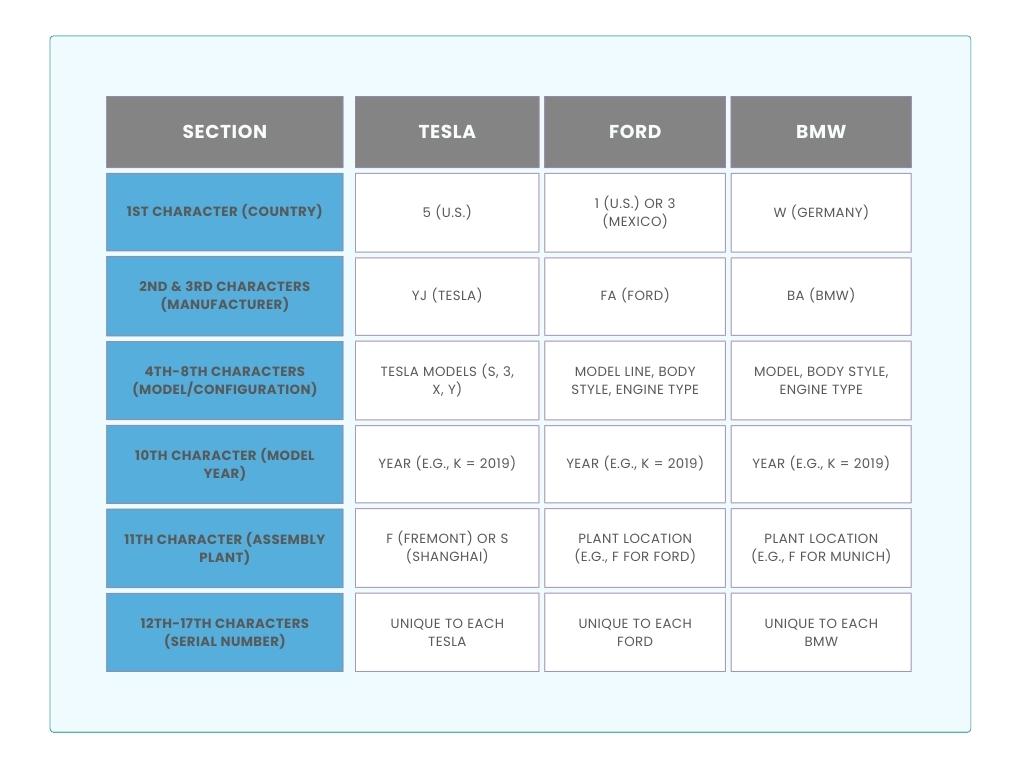When buying a vehicle, especially a used one, understanding its VIN (Vehicle Identification Number) is key. A VIN is more than just a unique identifier; it provides important information about a vehicle’s origin, model, engine specifications, and more. In this guide, we’ll compare the VIN structures of Tesla, Ford, and BMW to help you decode the meaning behind each digit. Whether you’re a Tesla fan, a Ford enthusiast, or a BMW owner, knowing how to read a VIN is an essential skill.

What is a VIN?
A VIN is a 17-character alphanumeric code assigned to every vehicle during production. This unique identifier acts like a fingerprint for a car, revealing critical details about its make, model, engine type, and more. Every manufacturer uses the same 17-character structure, but the specific layout varies from brand to brand.
Decoding the VIN can tell you everything from the vehicle’s place of manufacture to its production year. For Tesla owners, this is especially useful when you need to check your car’s history, its specific features, or if you’re buying a used Tesla. In this article, we’ll explore how VIN structures differ between Tesla, Ford, and BMW.
Tesla VIN Structure: A Breakdown
Tesla’s VIN structure follows the standard 17-character format but includes certain distinctions, especially as an electric vehicle manufacturer. Here’s what each section means:
- World Manufacturer Identifier (WMI):
The first three characters of the VIN identify the manufacturer and the country of origin. For Tesla, this typically starts with 5YJ, where:- 5 signifies the U.S. (Tesla’s main manufacturing hub),
- YJ identifies Tesla specifically.
- Vehicle Descriptor Section (VDS):
Characters 4 through 8 are used to describe the vehicle’s model, body type, and drivetrain. For example, the Model S will have different codes than the Model 3 or Model X. - Vehicle Identifier Section (VIS):
The final section, characters 10 to 17, includes details such as the model year, plant location, and a unique serial number. The 10th character represents the model year, the 11th represents the assembly plant, and the remaining digits are unique to your car.
Tesla’s VIN structure is tailored to accommodate electric vehicle details, such as battery size and drivetrain configuration.
Ford VIN Structure: A Breakdown
Ford’s VIN structure is also based on the 17-character format but follows a different pattern. Let’s break it down:
- World Manufacturer Identifier (WMI):
Ford’s WMI generally starts with 1FA for vehicles made in the U.S. or 3FA for those made in Mexico. The first three characters represent the manufacturer and plant location. - Vehicle Descriptor Section (VDS):
Characters 4 through 8 in Ford’s VIN describe the model, body style, and engine type. For example:- The 4th character represents the model line (e.g., “F” for the F-150),
- The 5th character refers to the body style (such as sedan or truck),
- The 6th and 7th characters indicate the engine type (gasoline, hybrid, etc.).
- Vehicle Identifier Section (VIS):
Ford’s VIS spans characters 10 to 17, revealing the model year, plant location, and serial number. Similar to Tesla, the 10th character indicates the model year, while the 11th represents the assembly plant.
Ford’s VIN emphasizes engine details, especially for their traditional gasoline-powered vehicles, compared to Tesla’s electric configurations.
BMW VIN Structure: A Breakdown
BMW follows the standard 17-character VIN format but incorporates unique codes that reflect the brand’s emphasis on luxury and performance. Here’s what each section means:
- World Manufacturer Identifier (WMI):
BMW’s WMI typically starts with WBA, signifying that the car was manufactured in Germany. - Vehicle Descriptor Section (VDS):
Characters 4 through 8 describe the model, body style, and engine type. For example:- The 4th character indicates the model (e.g., 3 for the 3 Series),
- The 5th and 6th characters describe the body style (coupe, sedan, etc.),
- The 7th and 8th characters reveal engine specifics, such as fuel type or power output.
- Vehicle Identifier Section (VIS):
The VIS section (characters 10 to 17) provides the model year, plant location, and unique serial number. BMW is known for offering a high degree of customization, so the VIN may also reflect trim packages and other specific options.
Comparing VIN Structures: Tesla vs. Ford vs. BMW
To make things clearer, here’s a side-by-side comparison of how each manufacturer’s VIN is structured:
Why Decoding Your VIN Matters
Decoding your vehicle’s VIN can provide valuable information, especially when buying a used car. It allows you to:
1️⃣ Verify the Vehicle’s Authenticity
The VIN is a great way to check if a car is authentic and hasn’t been stolen or tampered with. Using a Tesla VIN decoder or general VIN decoder helps you confirm details like model, production year, and engine type.
2️⃣ Access Vehicle Specifications
By decoding the VIN, you can uncover the exact specifications of your car, such as engine type, trim level, and assembly plant.
3️⃣ Track Service History
The VIN can help you check if your car has any outstanding recalls or maintenance history. This is especially important for Tesla owners, as understanding the vehicle’s service needs can help with long-term maintenance.
4️⃣ Check Insurance and Registration Details
VINs are often used by insurance companies and the DMV for vehicle verification. Ensuring your VIN is correctly listed can prevent issues with registration or coverage.
For Tesla owners, using a VIN decoder Tesla tool can give you detailed insights into the specific electric components of your car, such as battery size, motor type, and range.
Conclusion
Understanding the VIN of your car is essential for verifying its authenticity, uncovering its specifications, and ensuring its history is clear. While Tesla, Ford, and BMW all use the same 17-character VIN format, each manufacturer tailors its structure to reflect the unique characteristics of their vehicles. Tesla’s VIN emphasizes electric vehicle features, while Ford focuses on traditional gasoline engines. BMW offers detailed customization options, reflecting the luxury nature of the brand.
By decoding your vehicle’s VIN, you can ensure you’re making an informed decision, whether you’re buying a used Tesla, Ford, or BMW, or simply tracking your own vehicle’s history. Tools like a Tesla VIN decoder can help you unlock all the important details about your car.